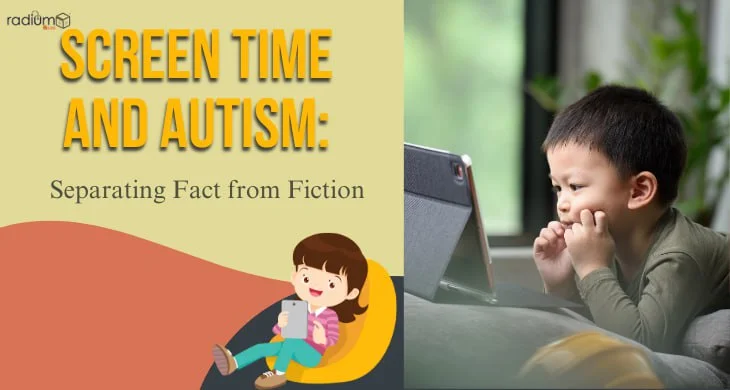In the contemporary digital landscape, the pervasive presence of screens has transformed the way we interact, learn, and entertain ourselves. Particularly for children, screen time has become an inseparable aspect of daily routines, raising questions about its repercussions on health and development. Among the concerns voiced by parents and experts alike is the potential correlation between excessive screen exposure and autism spectrum disorder (ASD). In this blog, we embark on a journey through the latest scientific inquiries, aiming to shed light on the nuanced relationship between screen time and ASD. By scrutinizing empirical evidence and expert insights, we endeavour to equip parents and caregivers with valuable knowledge to navigate the intricate terrain of digital engagement and its potential impact on the developmental trajectory of children with ASD.
Understanding Autism Spectrum Disorder
Before exploring the potential connection between screen time and autism spectrum disorder (ASD), it’s crucial to grasp the essence of ASD itself. ASD is a multifaceted neurodevelopmental condition marked by difficulties in social interaction, communication, and repetitive behaviors. This condition exists on a spectrum, encompassing a diverse range of symptoms and severity levels among individuals. Some with ASD may experience mild symptoms, while others may exhibit profound challenges that significantly impact daily functioning.
At its core, ASD affects how individuals perceive and interact with the world around them. Social interactions, such as understanding and responding to emotions, gestures, and social cues, can pose challenges for individuals with ASD. Communication difficulties may manifest in various forms, including delayed language development, difficulty initiating or maintaining conversations, and reliance on nonverbal communication methods like gestures or facial expressions.
Additionally, individuals with ASD often engage in repetitive behaviors or routines, which can provide a sense of comfort and predictability in their environment. These repetitive behaviors may include repetitive movements (e.g., hand-flapping or rocking), insistence on sameness or routine, and intense focus or fixation on specific interests or topics.
It’s important to recognize that ASD is a highly individualized condition, and no two individuals with ASD will experience the exact same set of challenges or symptoms. Understanding the diverse nature of ASD is essential for promoting acceptance, empathy, and support for individuals on the autism spectrum.
Exploring the Role of Screen Time
In today’s tech-savvy world, children and teens are immersed in a digital landscape filled with smartphones, tablets, computers, and other electronic gadgets. These devices offer a plethora of opportunities for entertainment, learning, and communication. However, as screen time becomes more prevalent, questions have arisen about its potential effects on neurodevelopmental disorders such as autism spectrum disorder (ASD).
While screen time can be beneficial in certain contexts, excessive or inappropriate use may pose risks to neurodevelopment. Some studies suggest that prolonged exposure to screens, particularly during critical periods of brain development, may affect neural pathways and alter brain function. This has sparked concerns among parents, educators, and healthcare professionals about the potential impact of screen time on children’s cognitive, social, and emotional development.
Specifically concerning ASD, researchers are investigating whether excessive screen time could contribute to the development or exacerbation of symptoms associated with the disorder. While the precise mechanisms underlying any potential link remain unclear, some theories propose that screen time may interfere with social interaction, communication skills, and sensory processing—all areas commonly affected in individuals with ASD.
Moreover, the content and context of screen-based activities may play a role in their impact on neurodevelopment. For example, passive screen time, such as watching television or scrolling through social media feeds, may offer fewer opportunities for active engagement and social interaction compared to interactive educational games or video calls with peers.
As digital technology continues to evolve and integrate into daily life, it is essential to critically evaluate the role of screen time in childhood development and its potential implications for neurodevelopmental disorders like ASD. By understanding the complex interplay between screen time, brain development, and neurodiversity, we can make informed decisions to promote healthy screen habits and support the well-being of children and adolescents.
The Research Landscape
As scientists delve deeper into the connection between screen time and autism spectrum disorder (ASD), they encounter a complex landscape of research findings. Some studies hint at a possible link between spending too much time in front of screens during early childhood and the likelihood of developing ASD or worsening its symptoms. However, it’s crucial to recognize that the evidence is not definitive, and conflicting results exist.
While some research suggests a correlation, other studies fail to find a clear association between screen time and ASD. This discrepancy underscores the need for more robust and longitudinal investigations to unravel the complexities of this relationship. Long-term studies tracking children’s screen habits from infancy through adolescence could provide valuable insights into the potential impact of screen time on neurodevelopment and ASD risk.
Moreover, researchers must consider various factors that could influence the observed associations. For instance, the type of screen activities, duration of exposure, and individual differences in neurodevelopmental trajectories may all play a role. Additionally, confounding variables such as genetic predispositions, environmental factors, and socioeconomic status need careful consideration when interpreting research findings.
Despite the uncertainty surrounding the link between screen time and ASD, caution is warranted when it comes to managing children’s screen use. Many experts recommend promoting balanced screen habits and encouraging a diverse range of activities that support healthy development. By staying informed and adopting a cautious approach, parents and caregivers can navigate the complexities of screen time and support the well-being of children with or at risk of ASD.
Potential Mechanisms
Scientists have put forward several theories to understand how spending too much time in front of screens could potentially impact autism spectrum disorder (ASD). One hypothesis revolves around changes in brain connectivity, suggesting that excessive screen time might interfere with the development of neural circuits involved in social communication and emotional regulation. Additionally, prolonged exposure to screens has been linked to disruptions in sleep patterns, which are known to affect cognitive function and emotional regulation—factors implicated in ASD.
Furthermore, the sensory overload caused by screen-based stimuli may overwhelm individuals with ASD, exacerbating sensory sensitivities and challenges in processing sensory information. This overstimulation can contribute to heightened anxiety and stress levels, further impacting behavior and social interactions.
Moreover, excessive screen time may detract from opportunities for face-to-face social interaction and communication, essential skills for individuals with ASD to develop and maintain. By prioritizing screen-based activities over real-world interactions, individuals may miss out on crucial opportunities for social learning and skill-building, potentially hindering their social and communication development. Overall, while these proposed mechanisms provide insights into the potential impacts of screen time on ASD, further research is needed to fully understand the complex interplay between screen exposure and autism spectrum disorder.
Navigating Screen Time Recommendations
Navigating the role of screen time in relation to autism spectrum disorder (ASD) can be challenging for parents and caregivers. While the scientific evidence is still evolving, it’s prudent to adopt a balanced approach to screen time. This means setting limits on the amount of time children spend in front of screens and encouraging alternative activities that support their overall development.
The American Academy of Pediatrics advises parents to establish clear guidelines for screen time, taking into account the age and developmental stage of their child. For younger children, it’s recommended to prioritize activities that promote physical activity, social interaction, and imaginative play. This might include outdoor play, reading books together, or engaging in creative arts and crafts.
Additionally, parents can model healthy screen habits by limiting their own screen time and actively engaging with their children during screen-based activities. By creating a supportive and interactive environment, caregivers can help mitigate any potential negative effects of excessive screen time while fostering healthy development and well-being in children with or without ASD. Ultimately, it’s about finding a balance that allows children to enjoy the benefits of technology while also nurturing their physical, social, and emotional growth.
Practical Tips for Parents
To promote a healthy screen time environment for children with or at risk of ASD, consider implementing the following strategies:
- Set clear limits on screen time and establish tech-free zones in the home.
- Encourage outdoor play, physical activity, and face-to-face interactions.
- Monitor the content and quality of screen-based activities, opting for educational and age-appropriate materials.
- Engage in joint media engagement, where parents and children explore digital content together.
- Prioritize sleep hygiene by establishing consistent bedtime routines and minimizing screen exposure before bedtime.
Conclusion
As our understanding of the relationship between screen time and autism spectrum disorder continues to evolve, it’s crucial for parents and caregivers to remain vigilant and intentional in their approach. While screens offer valuable educational and entertainment opportunities, moderation and mindfulness are key. By setting clear limits on screen time, encouraging alternative activities that promote social interaction and cognitive development, and modelling healthy screen habits ourselves, we can create a supportive environment for children’s growth and well-being. It’s about finding a balance that allows children to benefit from technology while also nurturing their physical, social, and emotional development. By prioritizing holistic well-being and staying informed about the latest research, we can help children thrive in today’s digital world while minimizing potential risks associated with excessive screen time.
FAQs
Ques. Can excessive screen time cause autism?
Ans. While research suggests a potential correlation between excessive screen time and autism spectrum disorder, more studies are needed to establish a causal relationship.
Ques. How much screen time is too much for children with ASD?
Ans. The American Academy of Pediatrics recommends limiting screen time for children with or at risk of ASD and prioritizing activities that promote social interaction, physical activity, and creative play.
Ques. What are some signs that screen time might be affecting my child’s ASD symptoms?
Ans. Signs that excessive screen time might be impacting ASD symptoms include changes in behavior, sleep disturbances, increased irritability, and difficulties with social interaction and communication.
Ques. Are certain types of screen-based activities more detrimental than others for children with ASD?
Ans. Some research suggests that passive screen time, such as watching television or videos, may be less beneficial than interactive screen activities that promote engagement and learning.
Ques. How can parents and caregivers support children with ASD in managing screen time?
Ans. Parents and caregivers can support children with ASD in managing screen time by setting clear limits, monitoring content, encouraging alternative activities, and modeling healthy screen habits themselves.




